One-Pot Synthesis of Silver Nanoparticles Derived from Aqueous Leaf Extract of Ageratum conyzoides and Their Biological Efficacy
Abstract
1. Introduction
2. Results
2.1. Phytochemical Analysis of Ageratum conyzoides
2.2. Silver Nanoparticle Synthesis
2.3. Characterization of Silver Nanoparticles
2.3.1. X-ray Diffraction (XRD) Studies of AC-AgNPs
2.3.2. FT-IR (Fourier Transform Infrared Spectroscopy) Analysis of Ac-AE and Ac-AgNPs
2.4. Gas Chromatography and Mass Spectroscopy (GC-MS) Analysis of Ac-AE
2.5. Field Emission Scanning Electron Microscopy (FE-SEM)
2.6. High-Resolution Transmission Electron Microscope (HR-TEM) Analysis of AC-AgNPs
2.7. Zeta Potential and Particle Size Distribution of AC-AgNPs
2.8. Purity Analysis with High-Performance Liquid Chromatography (HPLC)
2.9. Antibacterial Activity of Ac-AE and Ac-AgNPs
2.10. In Vitro Antioxidant Activity of Crude Plant Extracts
2.10.1. DPPH Radical Scavenging Capacity
2.10.2. FRAP Radical Scavenging Assay
2.10.3. H2O2 Radical Scavenging Assay
2.11. In Vitro Antiplasmodial Activity of Ac-AE and Ac-AgNPs
2.12. In Vitro Antidiabetic Activity of Ageratum conyzoides
3. Discussion
4. Materials and Methods
4.1. Plant Sample Collection
4.2. Aqueous Leaf Extract Preparation
4.3. Phytochemical Analysis of Ageratum conyzoides
4.4. Nanoparticle Synthesis
4.5. Nanoparticle Characterization
4.5.1. UV–Vis Spectroscopy Analysis
4.5.2. X-ray Diffraction Studies of AC-AgNPs
4.5.3. Functional Group Analysis of AC-AE and AC-AgNPs
4.6. Gas Chromatography and Mass Spectroscopy Analysis of AC-AE
4.7. FE-SEM Analysis
4.8. HR-TEM Analysis of AC-AgNPs
4.9. Particle Size Analysis of AC-AgNPs
4.10. HPLC Analysis of AC-AE
4.10.1. Preparation of Mobile Phase
Polar Extracts
4.11. Antibacterial Activity of Ac-AE and Ac-AgNPs
4.12. Antiplasmodial Activity
4.13. In Vitro Antidiabetic Activity
4.13.1. α-Amylase Inhibitory Activity
4.13.2. DPPH Radical Scavenging Assay
4.13.3. Ferric Ion Reducing Power (FRAP) Assay
4.13.4. Hydrogen Peroxide Scavenging Assay
Statistic Evaluation
5. Conclusions
Supplementary Materials
Author Contributions
Funding
Institutional Review Board Statement
Informed Consent Statement
Data Availability Statement
Acknowledgments
Conflicts of Interest
References
- WHO. Diabetes. 2013. Available online: http://www.who.int/mediacentre/factsheets/fs312/en/ (accessed on 13 December 2022).
- Abidullah, S.; Rauf, A.; Khan, S.W.; Ayaz, A.; Liaquat, F.; Saqib, S. A comprehensive review on distribution; paharmacological uses and biological activities of Argyrolobium roseum (Cambess.) Jaub. & Spach. Acta Ecol. Sin. 2022, 42, 198–205. [Google Scholar]
- Bhatti, H.A.; Rubina, R.; Rashid, F.; Zaib, S.; Iqbal, J.; Hameed, A. Synthesis and antitumor activities of novel Mannich base derivatives derived from natural flavonoids. Nat. Resour. Hum. Health 2022, 2, 100–106. [Google Scholar] [CrossRef] [PubMed]
- Margret Beula, J.; Sona Selva Malar, S.; Prasannakumar, S.; Ravikumar, S.; Kumaran, R. Variable drug bio availability of native seaweeds in India for antimalarial therapeutics. Drug Discov. 2015, 10, 93–99. [Google Scholar]
- Sharma, P.; Mohan, L.; Srivastava, C. Amaranthus oleracea and Euphorbia hirta: Natural potential larvicidal agents against the urban Indian malaria vector, Anopheles stephensi Liston (Diptera: Culicidae). Parasitol. Res. 2009, 106, 171–176. [Google Scholar] [CrossRef]
- Sharma, V.K.; Yngard, R.A.; Lin, Y. Silver nanoparticles: Green synthesis and their antimicrobial activities. Adv. Colloid Interface Sci. 2009, 145, 83–96. [Google Scholar] [CrossRef]
- Klein, G.; Kim, J.; Himmeldirk, K.; Cao, Y.; Chen, X. Antidiabetes and anti-obesity activity of Lagerstroemia speciosa. Evid. Based Complement. Altern. Med. 2007, 4, 401–407. [Google Scholar] [CrossRef]
- Perez-Gutierrez, R.M.; Damian-Guzman, M. Meliacinolin: A potent α-glucosidase and α-amylase inhibitor isolated from Azadirachta indica leaves and in vivo antidiabetic property in streptozotocin-nicotinamide-induced type 2 diabetes in mice. Biol. Pharm. Bull. 2012, 35, 1516–1524. [Google Scholar] [CrossRef] [PubMed]
- Kotta, J.C.; Lestari, A.B.; Candrasari, D.S.; Hariono, M. Medicinal effect, in silico bioactivity prediction, and pharmaceutical formulation of Ageratum conyzoides L.: A review. Scientifica 2020, 2020, 1–12. [Google Scholar] [CrossRef]
- Shuaib, M.; Hussain, F.; Rauf, A.; Jan, F.; Romman, M.; Parvez, R.; Zeb, A.; Ali, S.; Abidullah, S.; Bahadur, S.; et al. Traditional knowledge about medicinal plant in the remote areas of Wari Tehsil, Dir Upper, Pakistan. Braz. J. Biol. 2021, 83, e246803. [Google Scholar] [CrossRef] [PubMed]
- Das, T.K.; Ganguly, S.; Remanan, S.; Ghosh, S.; Das, N.C. Mussel-inspired Ag/poly (norepinephrine)/MnO2 heterogeneous nanocatalyst for efficient reduction of 4-nitrophenol and 4-nitroaniline: An alternative approach. Res. Chem. Intermed. 2020, 46, 3629–3650. [Google Scholar] [CrossRef]
- Das, T.K.; Ghosh, S.K.; Das, N.C. Green synthesis of a reduced graphene oxide/silver nanoparticles-based catalyst for degradation of a wide range of organic pollutants. Nano-Struct. Nano-Objects 2023, 34, 100960. [Google Scholar] [CrossRef]
- Chandraker, S.K.; Lal, M.; Ghosh, M.K.; Tiwari, V.; Ghorai, T.K.; Shukla, R. Green synthesis of copper nanoparticles using leaf extract of Ageratum houstonianum Mill.; study of their photocatalytic and antibacterial activities. Nano Express 2020, 1, 010033. [Google Scholar] [CrossRef]
- Madivoli, E.S.; Kareru, P.G.; Maina, E.G.; Nyabola, A.O.; Wanakai, S.I.; Nyang’au, J.O. Biosynthesis of iron nanoparticles using Ageratum conyzoides extracts, their antimicrobial and photocatalytic activity. SN Appl. Sci. 2019, 1, 1–11. [Google Scholar] [CrossRef]
- Wardani, M.; Yulizar, Y.; Abdullah, I.; Apriandanu, D.O.B. Synthesis of NiO nanoparticles via green route using Ageratum conyzoides L. leaf extract and their catalytic activity. In Proceedings of the IOP Conference Series: Materials Science and Engineering, Semarang, Indonesia, 7–8 September 2018; IOP Publishing: Bristol, UK, 2009; Volume 509, p. 012077. [Google Scholar]
- Chandraker, S.K.; Lal, M.; Shukla, R. DNA-binding, antioxidant, H2O2 sensing and photocatalytic properties of biogenic silver nanoparticles using Ageratum conyzoides L. leaf extract. RSC Adv. 2019, 9, 23408–23417. [Google Scholar] [CrossRef] [PubMed]
- Puro, K.N.; Mazumder, M.U.; Khazeo, P.; Jyrwa, R.; Jamir, N.; Sailo, L. Qualitative and quantitative analysis of phytochemicals of crude extracts of Ageratum conyzoides L. leaves. In Proceedings of the Mizoram Science Congress 2018 (MSC 2018), Aizawl, India, 4–5 October 2018; pp. 164–168. [Google Scholar]
- Ahmed, S.; Ahmad, M.; Swami, B.L.; Ikram, S. A review on plants extract mediated synthesis of silver nanoparticles for antimicrobial applications: A green expertise. J. Adv. Res. 2016, 7, 17–28. [Google Scholar] [CrossRef]
- Rodríguez-Bernaldo de Quirós, A.; Frecha-Ferreiro, S.; Vidal-Pérez, A.M.; López-Hernández, J. Antioxidant compounds in edible brown seaweeds. Eur. Food Res. Technol. 2010, 231, 495–498. [Google Scholar] [CrossRef]
- Shittu, K.O.; Ihebunna, O. Purification of simulated waste water using green synthesized silver nanoparticles of Piliostigma thonningii aqueous leave extract. Adv. Nat. Sci. Nanosci. Nanotechnol. 2017, 8, 045003. [Google Scholar] [CrossRef]
- Ojha, S.; Sett, A.; Bora, U. Green synthesis of silver nanoparticles by Ricinus communis var. carmencita leaf extract and its antibacterial study. Adv. Nat. Sci. Nanosci. Nanotechnol. 2017, 8, 035009. [Google Scholar] [CrossRef]
- Patra, N.; Kar, D.; Pal, A.; Behera, A. Antibacterial, anticancer, anti-diabetic and catalytic activity of bio-conjugated metal nanoparticles. Adv. Nat. Sci. Nanosci. Nanotechnol. 2018, 9, 035001. [Google Scholar] [CrossRef]
- Singh, K.; Naidoo, Y.; Mocktar, C.; Baijnath, H. Biosynthesis of silver nanoparticles using Plumbago auriculata leaf and calyx extracts and evaluation of their antimicrobial activities. Adv. Nat. Sci. Nanosci. Nanotechnol. 2018, 9, 035004. [Google Scholar] [CrossRef]
- Bajpai, V.K.; Shukla, S.; Kang, S.C. Chemical composition and antifungal activity of essential oil and various extract of Silene armeria L. Bioresour. Technol. 2008, 99, 8903–8908. [Google Scholar] [CrossRef] [PubMed]
- Marshall, K.; Joint, I.; Callow, M.E.; Callow, J.A. Effect of marine bacterial isolates on the growth and morphology of axenic plantlets of the green alga Ulva linza. Microb. Ecol. 2006, 52, 302–310. [Google Scholar] [CrossRef] [PubMed]
- Duan, X.J.; Zhang, W.W.; Li, X.M.; Wang, B.G. Evaluation of antioxidant property of extract and fractions obtained from a red alga, Polysiphonia urceolata. Food Chem. 2006, 95, 37–43. [Google Scholar] [CrossRef]
- Sullivan, R.T.; Kim, C.C.; Fontana, M.F.; Feeney, M.E.; Jagannathan, P.; Boyle, M.J.; Drakeley, C.J.; Ssewanyana, I.; Nankya, F.; Mayanja-Kizza, H.; et al. FCRL5 delineates functionally impaired memory B cells associated with Plasmodium falciparum exposure. PLoS Pathog. 2015, 11, e1004894. [Google Scholar] [CrossRef]
- Grover, J.K.; Yadav, S.P. Pharmacological actions and potential uses of Momordica charantia: A review. J. Ethnopharmacol. 2004, 93, 123–132. [Google Scholar] [CrossRef] [PubMed]
- Ravikumar, S.; Jacob Inbaneson, S.; Suganthi, P.; Gokulakrishnan, R.; Venkatesan, M. In vitro antiplasmodial activity of ethanolic extracts of seaweed macroalgae against Plasmodium falciparum. Parasitol. Res. 2011, 108, 1411–1416. [Google Scholar] [CrossRef]
- Harborne, A.J. Phytochemical Methods a Guide to Modern Techniques of Plant Analysis; Springer: Dordrecht, The Netherlands, 1998. [Google Scholar]
- Suresh, J.; Ragunath, L.; Hong, S.I. Biosynthesis of mixed nanocrystalline Zn–Mg–Cu oxide nanocomposites and their antimicrobial behavior. Adv. Nat. Sci. Nanosci. Nanotechnol. 2019, 10, 045014. [Google Scholar] [CrossRef]
- Rao, B.; Tang, R.C. Green synthesis of silver nanoparticles with antibacterial activities using aqueous Eriobotrya japonica leaf extract. Adv. Nat. Sci. Nanosci. Nanotechnol. 2017, 8, 015014. [Google Scholar] [CrossRef]
- SenthilKumar, P.; Sudha, S. Evaluation of alpha-amylase and alpha-glucosidase inhibitory properties of selected seaweeds from Gulf of Mannar. Int. Res. J. Pharm. 2012, 3, 128–130. [Google Scholar]
- Anjum, A.; Shetty, S.K.A.; Ahmed, M.A.N.Z.O.O.R.; Sridhar, B.K.; Vijaya, K.M.L. Development and validation of RPHPLC method for the quantitative estimation of cefadroxil monohydrate in bulk and Pharmaceutical dosage forms. Int. J. Chem. Sci. 2012, 10, 150–158. [Google Scholar]
- Moodley, J.S.; Krishna, S.B.N.; Pillay, K.; Govender, P. Green synthesis of silver nanoparticles from Moringa oleifera leaf extracts and its antimicrobial potential. Adv. Nat. Sci. Nanosci. Nanotechnol. 2018, 9, 015011–015018. [Google Scholar] [CrossRef]
- Deepak, P.; Amutha, V.; Birundha, R.; Sowmiya, R.; Kamaraj, C.; Balasubramanian, V.; Balasubramani, G.; Aiswarya, D.; Arul, D.; Perumal, P. Facile green synthesis of nanoparticles from brown seaweed Sargassum wightii and its biological application potential. Adv. Nat. Sci. Nanosci. Nanotechnol. 2018, 9, 035019. [Google Scholar] [CrossRef]
- Oloninefa, S.D.; Moses Enemaduku, A.; Safiya Yahaya, D.; Abdullahi, M. Characterization and Rate of Killing of Conjugated Silver Nanoparticles Against Selected Clinical Bacterial Isolates. Nat. Resour. Human Health. 2022, 2, 343–348. [Google Scholar] [CrossRef]
- Saqib, S.; Faryad, S.; Afridi, M.I.; Arshad, B.; Younas, M.; Naeem, M.; Zaman, W.; Ullah, F.; Nisar, M.; Ali, S.; et al. Bimetallic assembled silver nanoparticles impregnated in Aspergillus fumigatus extract damage the bacterial membrane surface and release cellular contents. Coatings 2022, 12, 1505. [Google Scholar] [CrossRef]
- Rasoanaivo, P.; Petitjean, A.; Ratsimamanga-Urverg, S.; Rakoto-Ratsimamanga, A. Medicinal plants used to treat malaria in Madagascar. J. Ethnopharmacol. 1992, 37, 117–127. [Google Scholar] [CrossRef]
- Azas, N.; Laurencin, N.; Delmas, F.; Di Giorgio, C.; Gasquet, M.; Laget, M.; Timon-David, P. Synergistic In vitro antimalarial activity of plant extracts used as traditional herbal remedies in Mali. Parasitol. Res. 2002, 88, 165–171. [Google Scholar] [CrossRef]
- Waako, P.J.; Katuura, E.; Smith, P.; Folb, P. East African medicinal plants as a source of lead compounds for the development of new antimalarial drugs. Afr. J. Ecol. 2007, 45, 102–106. [Google Scholar] [CrossRef]
- Matsui, T.; Ueda, T.; Oki, T.; Sugita, K.; Terahara, N.; Matsumoto, K. α-Glucosidase inhibitory action of natural acylated anthocyanins. 1. Survey of natural pigments with potent inhibitory activity. J. Agric. Food Chem. 2001, 49, 1948–1951. [Google Scholar] [CrossRef]
- Adeosun, A.M.; Oni, S.O.; Ighodaro, O.M.; Durosinlorun, O.H.; Oyedele, O.M. Phytochemical, minerals and free radical scavenging profiles of Phoenix dactilyfera L. seed extract. J. Taibah Univ. Med. Sci. 2016, 11, 1–6. [Google Scholar] [CrossRef]
- Al-Amiery, A.A.; Al-Majedy, Y.K.; Kadhum, A.A.H.; Mohamad, A.B. Hydrogen peroxide scavenging activity of novel coumarins synthesized using different approaches. PLoS ONE 2015, 10, e0132175. [Google Scholar] [CrossRef]


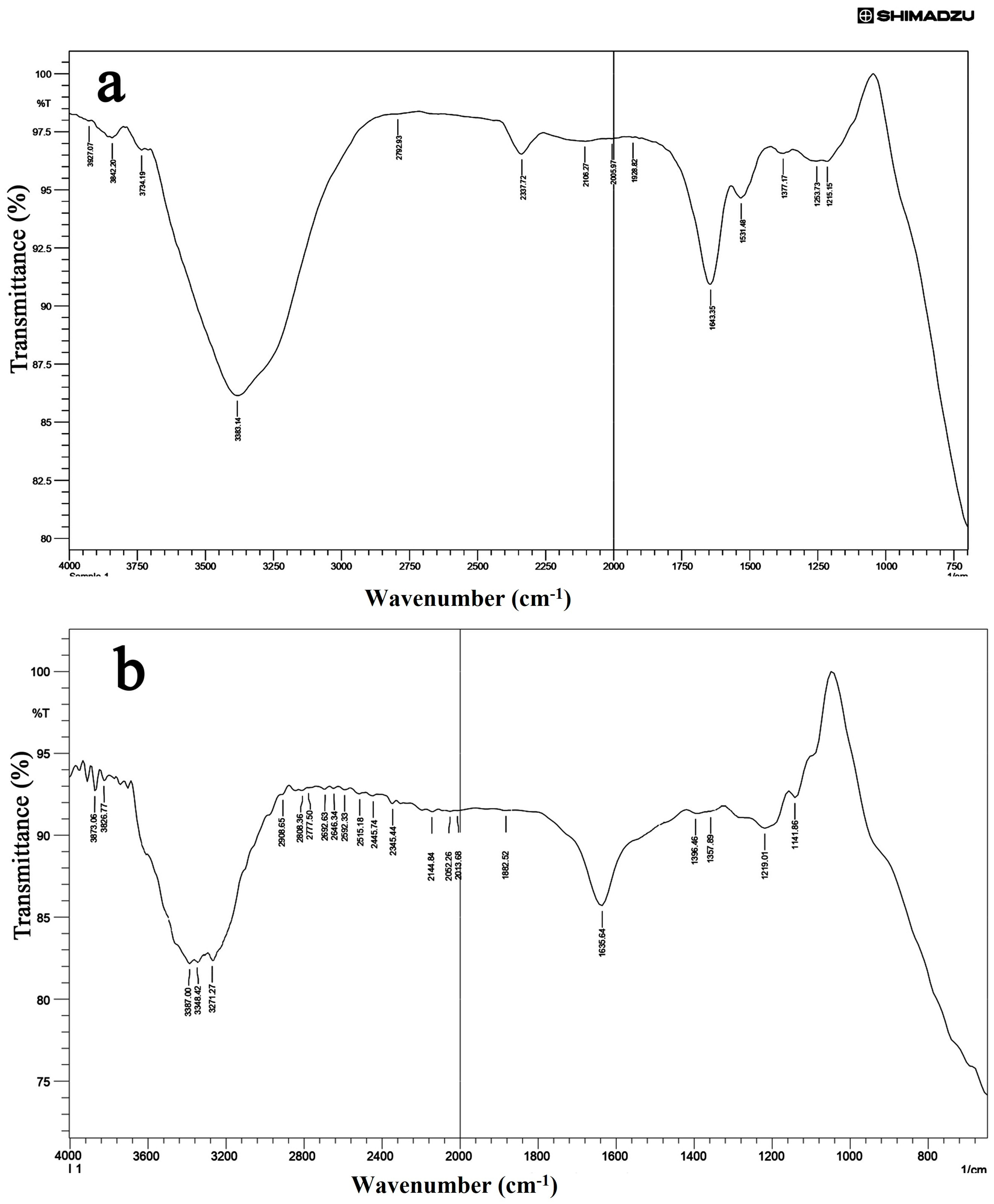



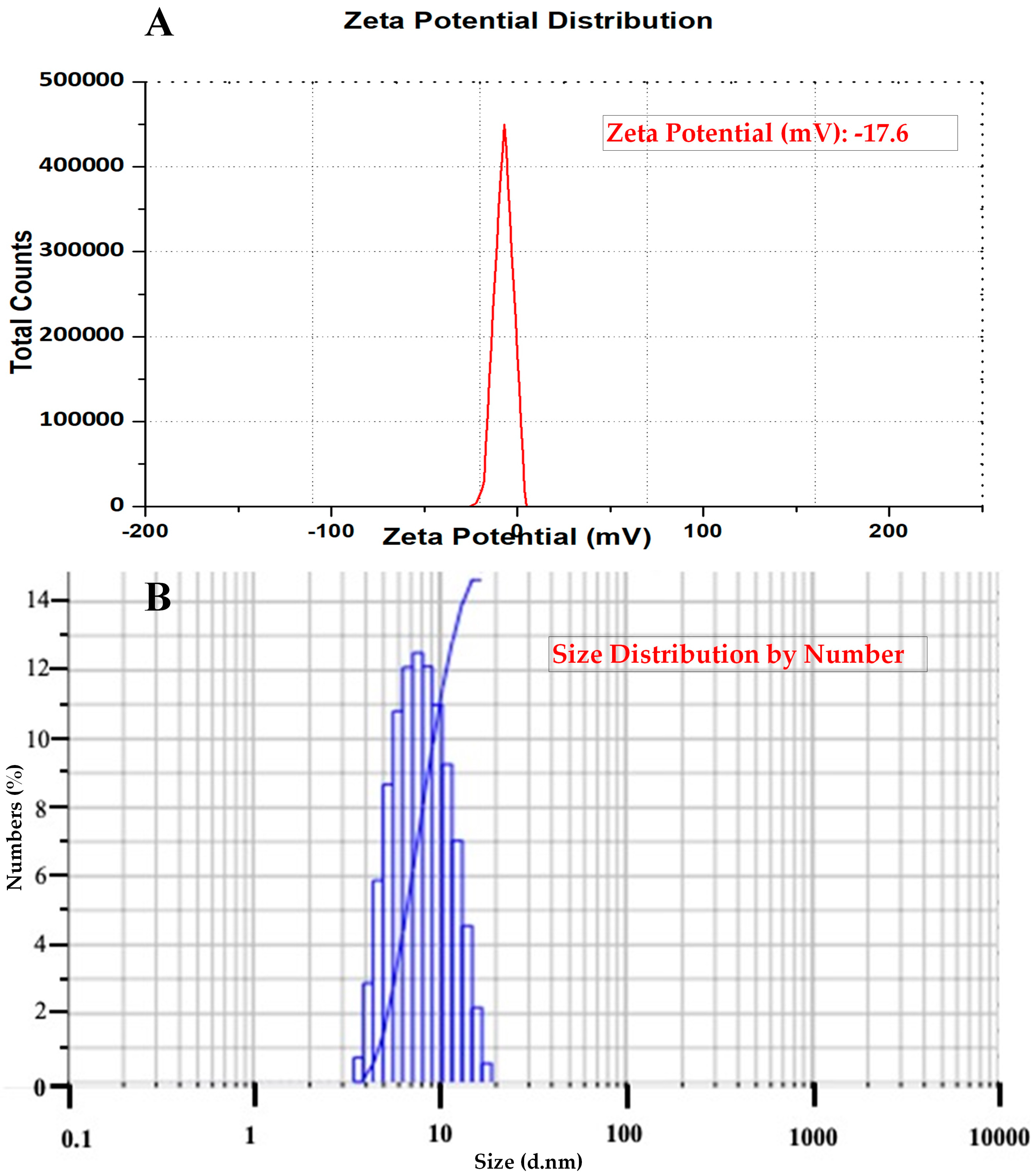
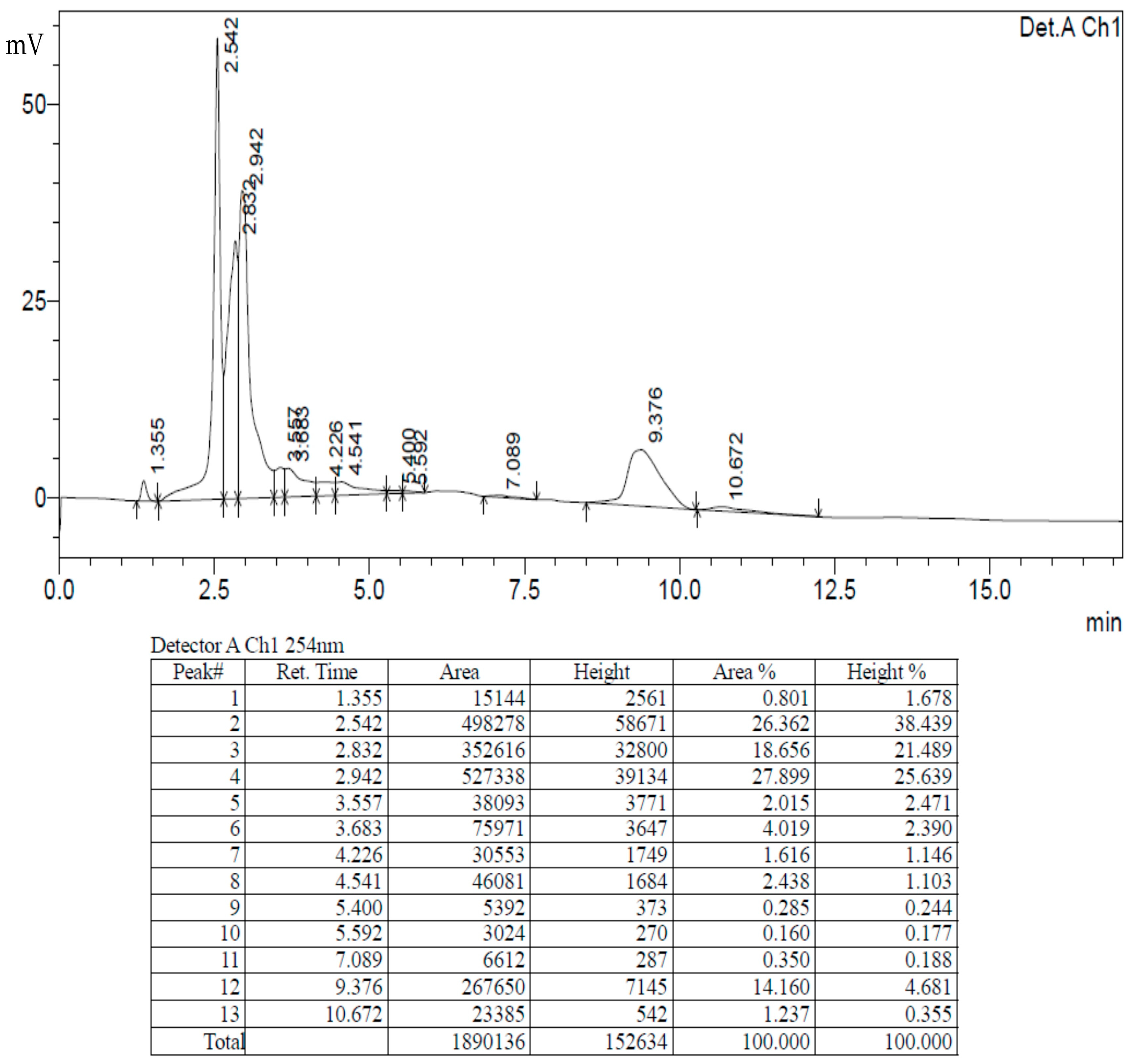

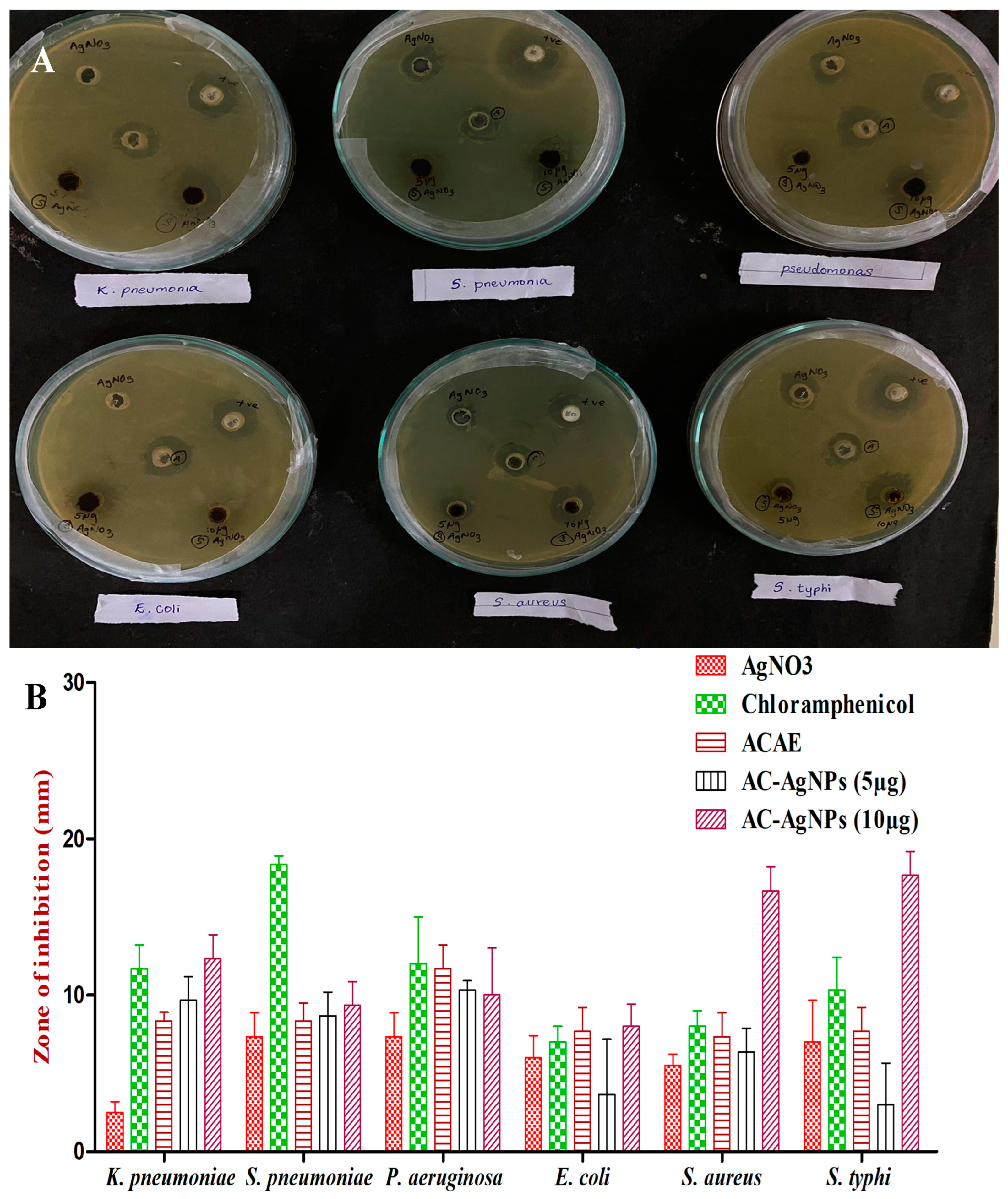
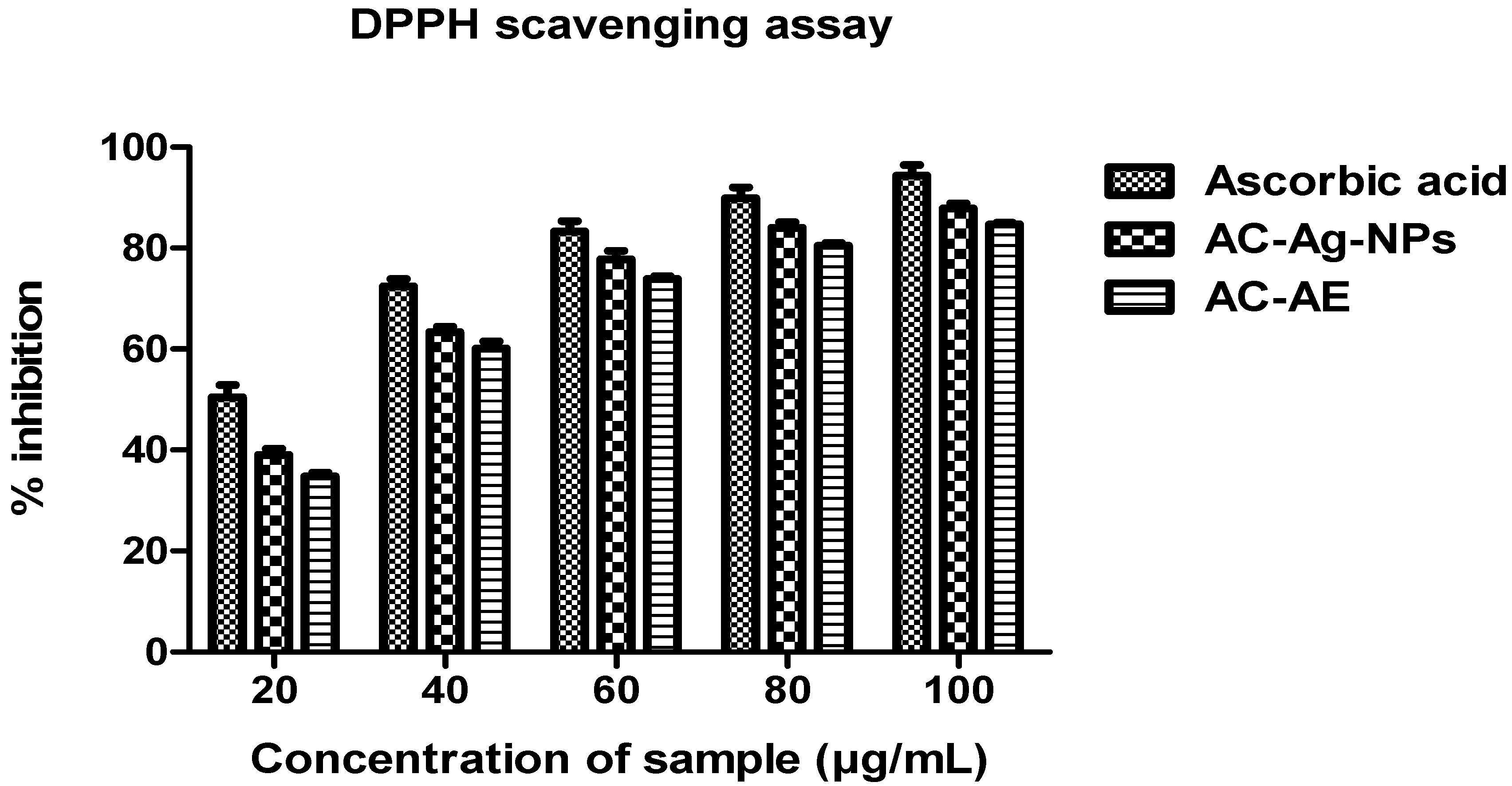
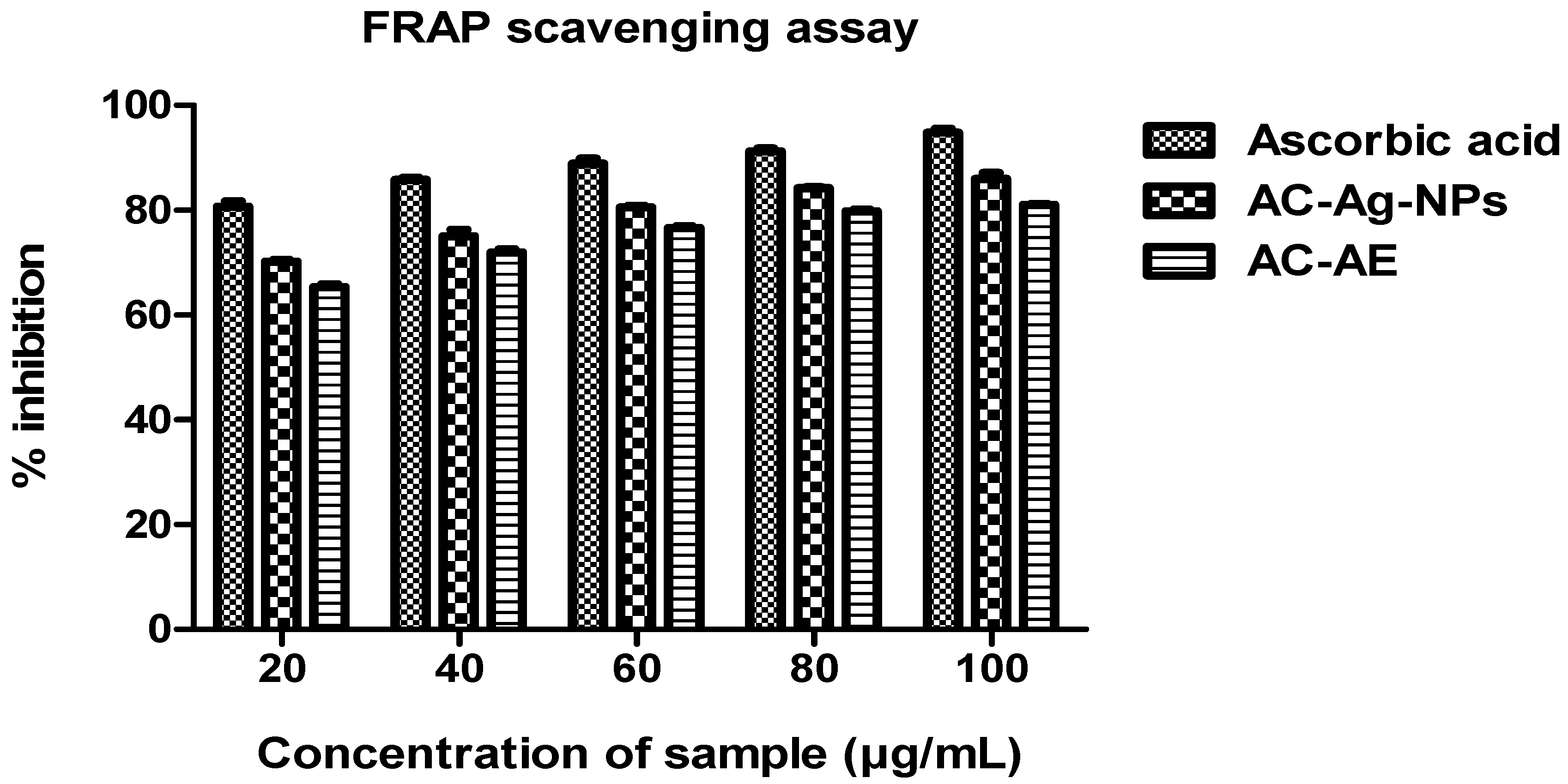

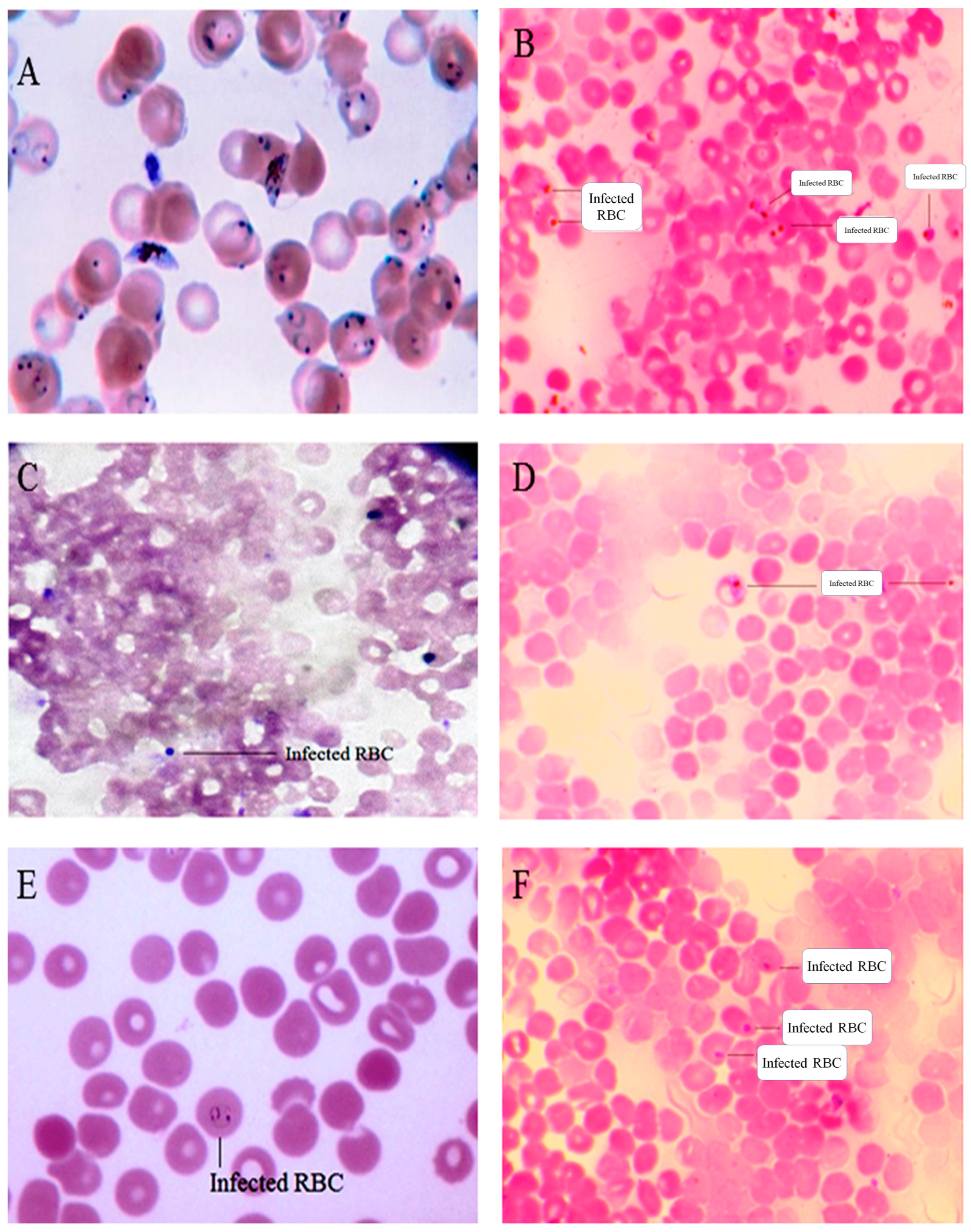

| Phytochemical | Presence/Absence |
|---|---|
| Alkaloids | + |
| Flavonoids | − |
| Glycosides | − |
| Steroids | + |
| Terpenoids | − |
| Saponins | + |
| Tannins | + |
| Cardiac glycosides | + |
| Frequency cm−1 | Bond | Functional Group |
|---|---|---|
| 3927.07 | O-H Stretching | Alcohols, phenols |
| 3842.20 | O-H Stretching | Alcohol, phenols |
| 3734.19 | O-H Stretching | Alcohol, phenols |
| 3383.14 | N-H Stretching | Aliphatic primary amine |
| 2792.93 | C-H Stretching | Aldehyde |
| 2337.72 | O꞊C꞊O Stretching | Carbon dioxide |
| 2106.27 | C≡C Stretching | Allene |
| 2005.97 | N꞊C꞊S Stretching | Isothiocyanate |
| 1928.82 | C꞊C꞊C stretching | Allene |
| 1643.35 | C꞊N stretching | Imine/oxime |
| 1531.48 | N-O Stretching | Nitro compound |
| 1377.17 | O-H bonding | Alcohol |
| 1253.73 | C-O stretching | Aromatic ester |
| 1215.15 | C-O stretching | Vinyl ether |
| Frequency cm−1 | Bond | Functional Group |
|---|---|---|
| 3873.06 | O-H Stretching | Alcohols, phenols |
| 3826.77 | O-H Stretching | Alcohol, phenols |
| 3387.00 | C-H Stretching | Aldehyde |
| 3348.42 | O꞊C꞊O Stretching | Carbon dioxide |
| 3271.27 | C꞊N Stretching | Imine/oxime |
| 2906.65 | N-O Stretching | Nitro compound |
| 2806.36 | C-O stretching | Aromatic ester |
| 2777.50 | C-O stretching | Vinyl ether |
| 2692.63 | C꞊C꞊C stretching | Allene |
| 2345.44 | C꞊N stretching | Imine/oxime |
| 2013.68 | N꞊C꞊S Stretching | Isothiocyanate |
| 1635.64 | C꞊C꞊C stretching | Allene |
| 1219.01 | N꞊C꞊S Stretching | Isothiocyanate |
| 1141.86 | C꞊C꞊C stretching | Allene |
| Percentage of Suppression of Parasitaemia at 24 h | |||||||
|---|---|---|---|---|---|---|---|
| Samples/Conc. | 100 | 50 | 25 | 12.5 | 6.25 | 3.125 | IC50 |
| AC-AE | 58.22 ± 0.11 | 48.05 ± 0.05 | 40.01 ± 0.06 | 31.79 ± 0.14 | 24.58 ± 0.17 | 17.99 ± 0.07 | 68.03 |
| AC-AgNPs | 74.96 ± 0.05 | 69.64 ± 0.14 | 58.19 ± 0.15 | 49.90 ± 0.10 | 42.08 ± 0.07 | 38.99 ± 0.08 | 17.65 |
| AgNO3 | 38.73 ± 0.14 | 29.08 ± 0.07 | 19.98 ± 0.07 | 12.66 ± 0.15 | 06.32 ± 0.15 | 0.00 ± 0.00 | >100 |
| Chloroquine | 80.50 ± 0.23 | 72.97 ± 0.09 | 65.22 ± 0.13 | 49.85 ± 0.12 | 42.22 ± 0.08 | 30.48 ± 0.24 | 14.75 |
| Artemether | 82.21 ± 0.10 | 74.29 ± 0.18 | 68.24 ± 0.16 | 49.90 ± 0.08 | 43.17 ± 0.12 | 32.7 ± 0.21 | 17.65 |
| Conc | Inhibition of α-Amylase | |||
|---|---|---|---|---|
| AC-AE | AC-AgNPs | AgNO3 | Acarbose | |
| 100 | 78.63 ± 0.16 | 88.56 ± 0.14 | 50.79 ± 0.18 | 85.10 ± 0.10 |
| 50 | 65.49 ± 0.27 | 76.36 ± 0.14 | 40.54 ± 0.16 | 77.94 ± 0.09 |
| 25 | 50.70 ± 0.18 | 65.40 ± 0.27 | 35.57 ± 0.16 | 69.23 ± 0.18 |
| 12.5 | 41.39 ± 0.12 | 50.73 ± 0.17 | 20.70 ± 0.18 | 53.38 ± 0.15 |
| 6.25 | 30.30 ± 0.14 | 38.71 ± 0.16 | 12.79 ± 0.14 | 46.60 ± 0.18 |
| 3.12 | 19.54 ± 0.16 | 20.73 ± 0.13 | 5.38 ± 0.17 | 35.93 ± 0.12 |
| IC50 | 37.02 | 21.52 | 85.46 | 7.96 |
Disclaimer/Publisher’s Note: The statements, opinions and data contained in all publications are solely those of the individual author(s) and contributor(s) and not of MDPI and/or the editor(s). MDPI and/or the editor(s) disclaim responsibility for any injury to people or property resulting from any ideas, methods, instructions or products referred to in the content. |
© 2023 by the authors. Licensee MDPI, Basel, Switzerland. This article is an open access article distributed under the terms and conditions of the Creative Commons Attribution (CC BY) license (https://creativecommons.org/licenses/by/4.0/).
Share and Cite
Paramasivam, D.; Balasubramanian, B.; Suresh, R.; Kumaravelu, J.; Vellingiri, M.M.; Liu, W.-C.; Meyyazhagan, A.; Alanazi, A.M.; Rengasamy, K.R.R.; Arumugam, V.A. One-Pot Synthesis of Silver Nanoparticles Derived from Aqueous Leaf Extract of Ageratum conyzoides and Their Biological Efficacy. Antibiotics 2023, 12, 688. https://doi.org/10.3390/antibiotics12040688
Paramasivam D, Balasubramanian B, Suresh R, Kumaravelu J, Vellingiri MM, Liu W-C, Meyyazhagan A, Alanazi AM, Rengasamy KRR, Arumugam VA. One-Pot Synthesis of Silver Nanoparticles Derived from Aqueous Leaf Extract of Ageratum conyzoides and Their Biological Efficacy. Antibiotics. 2023; 12(4):688. https://doi.org/10.3390/antibiotics12040688
Chicago/Turabian StyleParamasivam, Deepak, Balamuralikrishnan Balasubramanian, Ramya Suresh, Jayanthi Kumaravelu, Manon Mani Vellingiri, Wen-Chao Liu, Arun Meyyazhagan, Amer M. Alanazi, Kannan R. R. Rengasamy, and Vijaya Anand Arumugam. 2023. "One-Pot Synthesis of Silver Nanoparticles Derived from Aqueous Leaf Extract of Ageratum conyzoides and Their Biological Efficacy" Antibiotics 12, no. 4: 688. https://doi.org/10.3390/antibiotics12040688
APA StyleParamasivam, D., Balasubramanian, B., Suresh, R., Kumaravelu, J., Vellingiri, M. M., Liu, W.-C., Meyyazhagan, A., Alanazi, A. M., Rengasamy, K. R. R., & Arumugam, V. A. (2023). One-Pot Synthesis of Silver Nanoparticles Derived from Aqueous Leaf Extract of Ageratum conyzoides and Their Biological Efficacy. Antibiotics, 12(4), 688. https://doi.org/10.3390/antibiotics12040688









